Sheet
Music
Dominic Vautier 4-11
Keep the love light glowing
in your eyes so true
Let me call you “Sweetheart” I’m in love with you.[1]
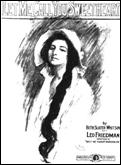 For
most of this country’s history, sheet music has been the guardian and
record keeper for song. It was the only media available to the industry
for all of the 18th and 19th centuries and for the
early part of the 20th century. No other way to communicate song existed except by word of mouth.
Before there was any such thing as radio or phonograph records,
sheet music was it. Long
before reel-to-reel tape recorders, CD’s, audio cassettes, video
cassettes, or even movie soundtracks, sheet music was the way a song was
recorded, played, transcribed, and remembered.
For
most of this country’s history, sheet music has been the guardian and
record keeper for song. It was the only media available to the industry
for all of the 18th and 19th centuries and for the
early part of the 20th century. No other way to communicate song existed except by word of mouth.
Before there was any such thing as radio or phonograph records,
sheet music was it. Long
before reel-to-reel tape recorders, CD’s, audio cassettes, video
cassettes, or even movie soundtracks, sheet music was the way a song was
recorded, played, transcribed, and remembered.
America
in 1830 was little more than a frontier. It was definitely a frontier as far as music went.
This country depended almost entirely on the Old World for its
music, and much of it was imported from England, France, and Italy.
Some early attempts to
publish local American music did occur. Some single-sheet ballads from the 1830’s[2]
and also some antebellum[3]
pieces can still be found, such as the ‘Corn Cobs’ published in
1836.[4]
But it appears that for the most part, published local American
music was sparse and rather poor in quality compared to the abundance of
fine music flowing out of Europe.
Despite
or maybe because of this feeble American activity, it was not until 1870
that the Library of Congress actually embarked upon the worthwhile but
belated venture of cataloging locally produced sheet music.
Most
of the time, we know who wrote the music but we don’t know too much
about who was responsible for the artwork on the sheet cover page.
Each publishing house usually employed one or more artists to
design the sheet covers, but they didn’t keep records on whom these
artists were.[5]
Even up until the turn of the 20th century, most of
the artists who designed the sheet-music covers remained unknown.
Making
the Sale
Sheet
music didn’t begin to sell heavily until 1892. It reached a high point
in 1910 when two billion copies were sold. That’s 22 sheets of music sold that year for every man, woman
and child in the country. From
then on the industry went into a steady decline. The number of actual sheets sold during the period of greatest
sheet-music production, from 1892 until 1915, was probably somewhere
around 10 billion, a
phenomenal number, considering how it had to be marketed.
Sheet
music could not be sold like other merchandise. The music publishers found out quickly that the standard methods
of retailing did not work at all. An
interesting attempt to use traditional advertising techniques occurred
in 1918, when Harry Link, an advertising executive, decided that he
wanted to sell music through normal advertising channels. After complete market saturation of the
Philadelphia
area, he ordered 25,000 advanced copies of a hot, new Berlin song, Smile and Show your Dimple. He
managed to sell only 2,500, and the whole project was a complete
failure.[6]
So
what made the sale of sheet music unique? People simply wanted to hear the music before buying it.
They wanted to sample the goods. It had to be advertised almost by word of mouth or, more
correctly, by word of voice. The
music publishers had to do their own advertising and expose their
products to the listening public at their own expense.[7] In fact, methods of selling music hadn’t changed much from
early 1890 until 1915.
After
1915 it became much easier to advertise music with all the newer methods
of communication, especially radio, which had begun playing music around
1922. A disk jockey could
reach literally millions of people instantly, whereas before mass
communications, it was a much harder job--it was a job for the pluggers.
Pluggers
 There
is abundant literature available today that describes the
adventure-packed lives and times of early song pluggers. These industrious entrepreneurs went to great lengths, even
physical confrontation, to succeed in their endeavors against an array
of stalwart competitors. These
people were high-powered, hired salesmen, not unlike the typical used
car or insurance salesmen of today, except that they were oftentimes
also highly motivated, gifted musicians, vaudevillians, and songwriters.
They were paid by the publishers to go out and demonstrate new
songs to anyone they could find who was willing to listen or, more
often, who didn’t want to listen at all. The pluggers were usually paid a wage, but sometimes the money
they earned depended on how hard they worked and how successful they
were at selling the songs that they were hired to advertise.
There
is abundant literature available today that describes the
adventure-packed lives and times of early song pluggers. These industrious entrepreneurs went to great lengths, even
physical confrontation, to succeed in their endeavors against an array
of stalwart competitors. These
people were high-powered, hired salesmen, not unlike the typical used
car or insurance salesmen of today, except that they were oftentimes
also highly motivated, gifted musicians, vaudevillians, and songwriters.
They were paid by the publishers to go out and demonstrate new
songs to anyone they could find who was willing to listen or, more
often, who didn’t want to listen at all. The pluggers were usually paid a wage, but sometimes the money
they earned depended on how hard they worked and how successful they
were at selling the songs that they were hired to advertise.
 Often
playing tricks on each other, the pluggers tried to outperform their
rivals: stories abound. Sometimes
pluggers would arrive at a site and find that another plugger had beat
them to the audience. At
other times pluggers would stage fake gatherings to lure their
adversaries away, get their competitors drunk or incapacitated, or give
rivals false leads and false directions, anything to get the competition
out of the way. Yet it was
all in the spirit of the business, and pluggers usually got along well
together. They understood
that music was in the family, that all musicians and song pluggers
shared a common bond, and that it was unwise to alienate a competitor
because someday that competitor could be a partner.
Often
playing tricks on each other, the pluggers tried to outperform their
rivals: stories abound. Sometimes
pluggers would arrive at a site and find that another plugger had beat
them to the audience. At
other times pluggers would stage fake gatherings to lure their
adversaries away, get their competitors drunk or incapacitated, or give
rivals false leads and false directions, anything to get the competition
out of the way. Yet it was
all in the spirit of the business, and pluggers usually got along well
together. They understood
that music was in the family, that all musicians and song pluggers
shared a common bond, and that it was unwise to alienate a competitor
because someday that competitor could be a partner.
No
public place in New York
was safe from the frenzy of the pluggers: beer parlors, music halls,
brothels, theaters, bicycle races, race tracks, boxing matches, parades,
baseball games, election campaigns, amusement parks.[8]
Wherever there were groups of people, there were bound to be song
pluggers.
The most successful songwriters, such as
Harry Von Tilzer, Jim
Thornton, and Irving Berlin, started out as song
pluggers. It was a career path, a right of passage, a method of education.
This unique experience gave these songwriters the inside track,
the edge they needed, because it taught them what music would work and
what would not. They gained
an added perspective, like a sixth sense. It was akin to politicians who went out to kiss babies and shake
hands.
Blanch Ring
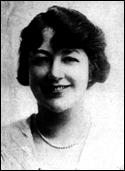 Sometimes
a publisher, if lucky, could get a big-name vaudevillian to plug
a song, since many of the more popular vaudeville performers were also
pluggers and would work for a fee or a percentage, or even do it as a
favor. If a publisher was
able to get one of the famous female baritones[9]
to plug his song, then he was almost guaranteed a success.
Sometimes
a publisher, if lucky, could get a big-name vaudevillian to plug
a song, since many of the more popular vaudeville performers were also
pluggers and would work for a fee or a percentage, or even do it as a
favor. If a publisher was
able to get one of the famous female baritones[9]
to plug his song, then he was almost guaranteed a success.
The
song plugger has always been needed in one form or another. When radio came along, the disk jockeys took over the roll of
plugger, and the industry continued to work the way it always had, by
demonstration as the primary method of selling. In music stores today there are automatic pluggers, devices where
the buyer is able to select and hear the song before buying it.
Distribution
In
1900 no stores such thing as music stores existed, but music stands were
everywhere; in barber shops, dry goods stores, department stores, and
especially apothecaries (drug stores). The smaller towns didn’t have specialized stores.
Instead, they usually had at least a general store or a barber
shop, which always had sheet music stands.
The
cities had more variety. Larger
stores (J.C. Penney,
Bloomingdale’s, Woolworth, and Macy’s) would sometimes have complete
departments set aside for the sale of sheet music, and the selection
there was much larger. There
was usually a piano on hand and a girl there to play music and
demonstrate songs. These
larger stores preferred to have girls work the music department because
they attracted customers more readily, were less 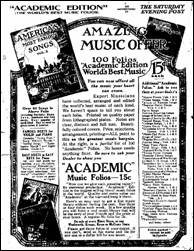 intimidating,
and played well.
intimidating,
and played well.
If you go to the cinema or rent videos, you know that movies always show
previews (trailers) because it is a good way to advertise new material.
The idea may have come from sheet music. Almost every piece of sheet music contained an advertisement or a
preview of other songs that the publisher had in his inventory. The system worked well because, using these advertising methods
along with the help of pluggers, sheet music sales were very robust for
almost 25 years, from 1892 until 1915.
Sometimes
various manufacturers attempted to print free music sheets so they could
advertise their own products, like corsets, medicines and chamber pots.
It’s hard to determine exactly how successful this practice
was; however, it probably didn’t succeed well based on the number of
surviving examples of this type of advertisement. Besides, selling chamber pots just wouldn’t work too well with
some songs, like I’m Forever
Blowing Bubbles, Has Anybody Here Seen Kelly or After
You’ve Gone.
A
Question of Time
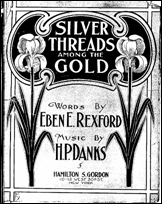 It
took Silver Threads Among the Gold
close to 30 years to sell a million copies. It took Oh Susanna
(1848) even longer. Both
songs can be considered successful. Before the emergence of radios and records, songs took a long
time to get circulated as the distribution system grunted and groaned
along on its ponderous journey. Hot
songs often took a few years to sell a million copies. Some songs were even exported to
England only to come back later as big hits.
It
took Silver Threads Among the Gold
close to 30 years to sell a million copies. It took Oh Susanna
(1848) even longer. Both
songs can be considered successful. Before the emergence of radios and records, songs took a long
time to get circulated as the distribution system grunted and groaned
along on its ponderous journey. Hot
songs often took a few years to sell a million copies. Some songs were even exported to
England only to come back later as big hits.
We
have a hard time seeing this today, since we are used to songs climbing
to the top of the charts within weeks and often disappearing just as
fast. Not so in this early
music period. After
the Ball and Daisy Bell
were able to arrive at million-seller status within one year, which may
translate roughly into less than one week by our time. Likewise Meet Me Tonight in
Dreamland and Let Me Call You
Sweetheart together sold over 10 million copies within one year, an accomplishment against which there is no
comparison in today’s world. Not
even the frenzy of Beatlemania can compare to this shattering pace.
The
Song Sheet Makeup
Sheet
music came in two sizes; the old style song sheet measured about 11
inches wide and 14 inches high, and the smaller size sheet was 9 by 12
inches. Pieces were printed
in the larger size until about 1910, when the piano music holders began
to get smaller and publishers wanted to save paper and transportation
costs. The 9 by 12 size
started appearing about that time and became the standard after the
First World War, but a few of the larger sized sheets continued to be
made as late as 1918. Some
people say the sheet size got smaller to save paper for the war effort,
but that’s hardly a reason at all since we never had a shortage of
paper. Besides, the smaller
size started being sold well before the war.
 Some
music came in books of songs, marches, or waltzes, but most of the time
each piece contained one song and was usually made up of one double
folded sheet with a single sheet inside, making a total of three pages
or six sides. Since one side
was for the cover and another for advertisement, four sides were left
for the music. The
songwriters had to consider this problem when they published. Most songs had to be written and arranged in a way that
accommodated four printed pages.
Some
music came in books of songs, marches, or waltzes, but most of the time
each piece contained one song and was usually made up of one double
folded sheet with a single sheet inside, making a total of three pages
or six sides. Since one side
was for the cover and another for advertisement, four sides were left
for the music. The
songwriters had to consider this problem when they published. Most songs had to be written and arranged in a way that
accommodated four printed pages.
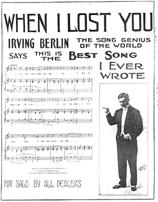
The
advertisement was usually a full page on the inside front cover or on
the back, and it generally showed other songs available through the
publisher. Included at the
end of this chapter is a complete song sheet to demonstrate covers,
advertisements, and music. Anthologies
and collections rarely show the complete song sheet.
After
1900 the front cover was often done in color, and some covers are very
artistic. However, more
often there was just a title and the picture of a singer or famous
plugger who popularized the song. This
practice was carried forward into the recording industry, when singing
stars became the main advertisers for a song and often appeared on the
record jacket. The back of
record jackets advertised other songs by the same publisher, a
continuation of the sales practices used in sheet music.
 Included
also in the cover was the
Included
also in the cover was the
 publishing
house. Publishing houses
had their own logo. Sometimes
there was a picture of the songwriter or lyricist or, more frequently,
the publisher. The copyright
date appears on the inside cover on the first page. Often it was in roman numerals to confuse everybody.
publishing
house. Publishing houses
had their own logo. Sometimes
there was a picture of the songwriter or lyricist or, more frequently,
the publisher. The copyright
date appears on the inside cover on the first page. Often it was in roman numerals to confuse everybody.

Song
sheets did not always have a list price. The
price for a piece of sheet music was could be 25 to 50 cents, although
they could be gotten for less. When
price wars came, the cost could get down to 5 cents a sheet. Publishers could print sheet music for probably 2 cents a copy, so
even at this low bargain price, there was still an opportunity for
profit.
I
have a number of older copies of sheet music shown in their entirety at My
Sheet Music.
Categories
Sheet
music collectors love to organize their material, and here is a typical
breakdown.
Rag
– A rag is anything that has the word “rag”, “ragging”, or
“ragtime” in its title. The
song may or may not be a rag, and even the definition itself can be
confusing. Sheet music
collectors don’t make distinctions between classic or popular rags.
To them it’s all ragtime. Typical
songs under this category are: Nervous
Rag, RagBag Rag, Maple Leaf Rag, Ragging the Baby to Sleep, and Alexander’s
Ragtime Band (which some collectors consider a march or a
rag/march).
 Fox trot - Chris Smith’s Ballin’
the Jack[10]
is considered the first recorded fox trot, but other
foxtrotable (slow slow quick quick) songs were around before Harry Fox, the
inventor of the fox trot. Nevertheless
any song published before 1914 is not considered a real fox trot. Fox trots usually have something on the cover that gives them
away. Typical fox trots
include: Carolina
Fox Trot, Doctor Brown, The Kangaroo Hop, and Palm Beach.
Fox trot - Chris Smith’s Ballin’
the Jack[10]
is considered the first recorded fox trot, but other
foxtrotable (slow slow quick quick) songs were around before Harry Fox, the
inventor of the fox trot. Nevertheless
any song published before 1914 is not considered a real fox trot. Fox trots usually have something on the cover that gives them
away. Typical fox trots
include: Carolina
Fox Trot, Doctor Brown, The Kangaroo Hop, and Palm Beach.
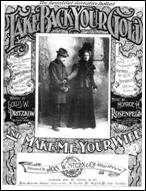 Tearjerker – From 1885 up until 1902, there was a particular type
of emotionally charged song that was labeled a tearjerker. These songs shared the familiar themes of lost love, errant love,
misplaced love, missing love, dead children, dead lovers, injured feelings, and
other kinds of pathos. The
most famous among them was After
the Ball. Tearjerkers
were the forerunners of the torch songs of the 1930’s. The three
kings
of the tearjerker were Harry Kennedy, Paul
Dresser, and Charles
Harris. Most of the songs
were slow waltzes, but they fall into this category mainly because of
their excessively lugubrious content. Some
famous tearjerkers were: Cradle’s
Empty, Baby’s Gone, Fallen, Just Tell Them That You Saw
Me, and
Take Back Your Gold.
Tearjerker – From 1885 up until 1902, there was a particular type
of emotionally charged song that was labeled a tearjerker. These songs shared the familiar themes of lost love, errant love,
misplaced love, missing love, dead children, dead lovers, injured feelings, and
other kinds of pathos. The
most famous among them was After
the Ball. Tearjerkers
were the forerunners of the torch songs of the 1930’s. The three
kings
of the tearjerker were Harry Kennedy, Paul
Dresser, and Charles
Harris. Most of the songs
were slow waltzes, but they fall into this category mainly because of
their excessively lugubrious content. Some
famous tearjerkers were: Cradle’s
Empty, Baby’s Gone, Fallen, Just Tell Them That You Saw
Me, and
Take Back Your Gold.
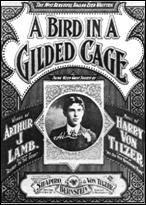 Waltz – All waltzes, or three-steps, are generally grouped
together, regardless of whether they were Viennese, Bostons, or
Hesitations, which are all variations of the waltz step. This period was almost overwhelmed by waltzes, for
example, Meet Me Tonight in
Dreamland, I Wonder Who’s Kissing Her
Now, Let Me Call You Sweetheart,
Bird in a Gilded Cage, and
My
Pal Sal. The last two
songs are also tearjerkers.
Waltz – All waltzes, or three-steps, are generally grouped
together, regardless of whether they were Viennese, Bostons, or
Hesitations, which are all variations of the waltz step. This period was almost overwhelmed by waltzes, for
example, Meet Me Tonight in
Dreamland, I Wonder Who’s Kissing Her
Now, Let Me Call You Sweetheart,
Bird in a Gilded Cage, and
My
Pal Sal. The last two
songs are also tearjerkers.
March
– A march is anything that has the
word "march" on the cover and is played in march time. There were a lot of sheet-music marches.
Marches are not strictly popular music. While many of the Sousa pieces became popular, no march ever sold
a million copies, although Washington
Post did come close.
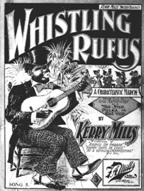 Cakewalk
– Cakewalks are two-steps but they
usually say on the cover that the song is a cakewalk.
Some confusion exists here since we can have cakewalk
two-steps, cakewalk marches, and other variations of this dance. A typical example of confusion is seen with Whistling
Rufus, which is described on the cover as a two-step, polka, and
cakewalk, all at the same time.
Cakewalk
– Cakewalks are two-steps but they
usually say on the cover that the song is a cakewalk.
Some confusion exists here since we can have cakewalk
two-steps, cakewalk marches, and other variations of this dance. A typical example of confusion is seen with Whistling
Rufus, which is described on the cover as a two-step, polka, and
cakewalk, all at the same time.
Blues
- Any song sheet that has “Blues”
on it is Blues. It did not
become popular until after 1915.St. Louis Blues was the first of its kind.
Dialect
– Music done in dialect can be considered dialect or “coon” music.
Racial stereotypes were an acceptable and legitimate vehicle for
musical expression during these early times. Some of the very popular sheet music of the late 19th
century was done in dialect because such songs used fast ragtime
rhythms and syncopation. It
was therefore expected that the dialect songs would have these
qualities. Some very popular
dialect songs, selling over 1 million copies, were I’d
leave my Happy Home for You, If
the Man in the Moon Were a Coon, and
Coon, Coon, Coon.
Indian
Intermezzo – In 1907 a type of song appeared extolling the
adventures and achievements of Native Americans in battle and love.
This group of songs came to be known as Indian Intermezzos,
although they are neither Indian in origin nor are they intermezzos.
Indian Intermezzos are done in cut time[11]
to imitate Indian drums or something like that. Their
sheet covers are often beautifully adorned with bronze or godlike Indian
figures. The most popular of
songs in this group were Red Wing, Silver Heals, and
RedMan.
Two-step
– If a song is labeled “two step” then it belongs in this
category.[12]
Often the sheet cover describes the song in this way. It's
probably a one-step.
Novelty
songs – Items that don’t fit into any of the above categories,
including two-steps, are novelty songs. The content qualifies a song as a novelty.
If the song does not deal with love, lost kids, dancing,
marching, Indians, or dialect, and it's funny then it is probably a novelty song.
A good example is; Who
Threw the Overalls in Mrs. Murphy’s Chowder, On the
5:15, and
He’d Had to Get Under, Get Out and Get Under, and Fix Up His
Automobile.
If you’re not a collector, it is
hard to understand how the tearjerker and Indian intermezzo categories
came into existence in the first place. Most of the other types of sheet music are grouped by music
style, yet these two categories are simply musical content designations,
a distinction that is arbitrary at best. Also, how does one categorize the dialect songs that frequently
became mainstream songs after a short while, such as Bill
Bailey, Goodbye, My Lady Love, and many others?
To sheet music collectors, however,
strict library logic or exact historical context isn’t important.
They just want to organize the types of music the way this music
has always been organized. Tearjerkers
were called that in 1892, and the distinction has stayed with us. To throw all rags together is perfectly legitimate because, to
sheet music collectors, there is no difference between them. A rag is anything that has “rag” in the title.
So Maple Leaf Rag goes with Alexander’s
Ragtime Band just fine, two songs that come from different time periods and
are vastly different. For
the collector it doesn’t matter.
The
End
Well-developed family traditions
had developed in
the decade before the turn of the 20th century which revolved around the parlor piano
and its necessary constituent sheet music. So the Sunday ritual was set: best Sunday clothes, church in the
morning, lunch, afternoon walks in the park, late afternoon visits perhaps, and then an evening around the parlor piano.
In this way the piano and its collection of sheet music became a part of middle-class American life.
But
as
the 20th century moved forward, family institutions began to change.
Children no longer wanted to remain at home after marriage. They even wanted to move to other parts of the country.
Sons who went off to fight the Great War came back with different
attitudes. The war had
profoundly changed them, and in a way, they could never really go home
again.[13]
It was
How 'ya Gonna Keep 'em down on the Farm.
 How
you gonna keep ‘em down on the farm after they’ve seen Paree.[14]
How
you gonna keep ‘em down on the farm after they’ve seen Paree.[14]
Daughters
left to find jobs outside home and, once married, began to do the
unthinkable--postpone having families. Fathers wondered why their offspring no longer wanted to pursue
the family business. The
family unit that supported the purchase and use of sheet music up until
1915 had itself begun to change, and by 1920 the piano, along with
it’s sheet music component, was no longer a part of the essential
family formula.
Piano
sales had been strong all throughout the 1890’s and 1900’s, and lots
of people knew how to play. Not
only that, but popular sheet music was purposely “dumbed-down”, that
is, designed to be easy to play and sing to. There was not very much complexity in chord structure, notation,
or tempo; it was easy stuff for sure. Only one or two years of piano practice provided enough skill to handle just
most of the popular sheet music of
that time.
But
as the next century rolled in, it brought more sophisticated types of
music. It was fine for old
Jake and young Sally to sit down and pick out an American waltz or a
tearjerker in slow time. But
the newer material was of a different sort, and their talent fell short
when confronted with fast rags and syncopated cakewalks. Piano music started becoming more specialized, and this drove out
the many so-so piano players, leaving room for just the good ones.
As piano playing became more difficult, sheet music started to
lose some of its clientele. The
market was being abandoned to the professionals.
Sheet
music also necessitated involvement. There is a fundamental difference between those who sing in a
choir or barbershop quartet and those who merely listen. One role is active and obligatory, while the other is passive and
optional. In one case, creative goals
require effort and sometimes talent. In the other case, attention is purely coincidental and the only
requirement is working ears. The
more intricate sheet music became, the more time it demanded, which was
contrary to the lifestyle that was developing. It just didn’t fit in with the faster pace of life that began
to appear after 1910.
Sheet
music also needed a somewhat large indirect investment. An expensive piano was necessary to be truly part of the sheet
music experience. And the piano
needed a parlor. There had
to be someone who could play, and singers were part of the deal as well.
So this type of music did not come spontaneously, easily, or
quickly. It was not
something that could happen at the turn of switch. It had to be organized.
Sheet
music was not portable. America had
the bicycle, the trolly and by
1915 the car. We were becoming a nation on wheels. People wanted to just pick up and go to the beach, the ocean, the
mountains, the park, and bring their music with them. The record industry was able to satisfy this need.
Portable music was not just a sales gimmick or marketing device. It was a whole new technology replacing an older, obsolete one.
Portable music represented what this younger, on-the-go society
really wanted. Sheet music
was part of the old, tired, effete parlor culture.
Another
reason sheet music died was that it could not handle the new forms of
music, Blues and Jazz. Records
could. The Blues and Jazz
both rely on blue notes, usually a quarter-step flattened third or
fifth, which can’t be done on a piano. Blue notes can be represented in music, sung, and played on many
instruments, including clarinets, trombones, and any other of the
various horns, but it can't be reproduced on a fixed-scale instrument.
It falls between the piano keys, and the sheet music industry was
primarially a supplier of piano music. By 1915 Memphis Blues had become popular.
By 1917 the Original
Dixieland Jazz Band began recording Jazz for Victor, and the sale of
these first Jazz recordings was brisk. But the Jazz sheet music did not do well at all, an ominous sign
of the dwindling interest in sheet music.
Keep
The Love Light Shining
The
era of sheet music began in 1892, when there was a dramatic increase in
the need for popular piano entertainment. Americans suddenly found themselves with leisure time and money
to spend. What did they buy? They bought sheet music by the tons.
The
rapid growth of sheet music sales can also be attributed to the
development of certain traditions that had been building since the Civil
War, such as the need to maintain a strong family unity in an unknown
and sometimes hostile environment. The
wholesale movement to the cities, the rapid increase in the birthrate,
and the huge influx in immigration produced within the family unit a
desire to stabilize and maintain some kind of fixed point by
concentrating on strength and cohesion.
Piano
companies had for years fostered the idea of a family nucleus built
around the piano. The parlor
was a major focus and social center of the home, and every parlor needed a
piano. Accordingly, every
piano needed a good supply of sheet music. Sheet music was one of the things that contributed to stability
because it gave the family something very intimate that they could do
together.
However,
by 1915 the traditional family unit had begun to disintegrate and
children wanted to break away. Young
men and women no longer would live under the same roof with their
parents, nor work the same trades. Society
was beginning to adopt the fast-moving, throwaway mentality that was to
mark the decade of the 1920’s.
The
Blues and Jazz were new music forms that sheet music could not easily
adjust to. Improvisation and
blue notes were beyond the ability of the older forms of piano-based
written music. The natural
spontaneity of Jazz could only be captured in real life or on record.
Of
all the things that destroyed the market for sheet music, none was more
responsible than the record industry, which by 1915 had standardized
methods of recording and reproduction. The record addressed the new American image of mobility,
immediacy, independence, disposability, and even quick wealth.
Like
the McGuffey Reader, sheet music had seen it’s heyday and had left a
deep and abiding imprint on the American psyche. The feeling of family unity was never so strong as when it was
closely associated with that thin, flimsy, easily ripped piece of paper.
Sheet music was thereafter almost to become an American symbol of lost
innocence.
A
Finite Thing
Not
much old sheet music is left today, only a small fraction of the 10
billion originally produced is still in existence.
The sheet music was printed on cheap paper that tended to
turn yellow quickly because of inadequate acid elimination. The inexpensive and flimsy quality of paper also made it tear
easily. Once a sheet got
worn out or ripped, it was discarded (there was no Scotch tape). After all, the stuff was inexpensive, easy to replace and nobody
saw any point in keeping ugly, dog-eard, crumpled-up sheet music around
for very long, especially after it got used a lot. Piano benches tended to fill up rapidly, so with the spring
cleaning, out went a lot of the worn out sheet music. Old sheet music is a finite thing, in
limited quantity, valuable, like gold. Whatever does remain has been gathered and preserved in
collections and displays. There
will never be any more of it produced, ever, and what we now have now is all we will ever have.
Quite
a bit of interest in old sheet music collection exists. Most of the music has been cataloged and priced by collectors.
Pieces generally fall into the 5-dollar range, although rare
copies can sell for much more. The
rarest of all, the apocryphal little-Egypt version of She
Never Saw the Streets of Cairo, is probably quite valuable, if even one
is ever found.
I
sometimes browse my own collection of old
music, wondering how
many times these pieces were played and how many times the pages were
turned. I can imagine the
flow of Daisy
Bell, Teasing, and Can’t You Hear Me Calling, Caroline. The
emotion is there before me on that old paper. I
think the old yellowed paper has absorbed it.
Here are some other links in this
article:
Origins
of Early Popular Music
Minstrelsy
Broadway
Vaudeville
Other sources
People
Growth - the First Baby Boom and it's effect
How
Dancing Helped Music
Women
and Early Music
Some
Early Songwriters
Some
Songs
The
Influence of the Piano
Recorded
Music
Chronicles
1892-1900
Chronicles
1901-1915
Million
Sellers
[1]
Beth Whitson & Leo Friedman,
Let Me Call You Sweetheart, 1910. This song sold well over 5 million copies and was one of the
most successful sheet music pieces of all time.
[2]
Marian Klamkin, Old Sheet Music: A Pictorial History (New York: Hawthorn Books,
Inc., 1975), 7.
[3]
Before the Civil War.
[4]
Klamkin, 7.
[5]
Klamkin, 10.
[6]
Hazel Meyer, The Gold in Tin Pan Alley (New York: J. B. Lippincott Company,
1958), 48.
[7]
Meyer, 44.
[8]
Meyer, 46.
[9]
They weren’t baritones at all. They were altos who sang in an emotional way.
[10]
Balling the jack means to act quickly and with enthusiasm, as
sailors putting a ball in the gun (jack).
[11]
2/4 time.
[12]
By 1899 the two-step, or march step had disappeared and had been
replaced by the one-step. Music
publishers continued calling it a two-step anyway.
[13]
My father had this experience.
[14]
Rida Young, Lewis & Walter Donaldson, How
Ya Gonna keep ‘Em Down on the Farm After They’ve Seen Paree,
1919.
 For
most of this country’s history, sheet music has been the guardian and
record keeper for song. It was the only media available to the industry
for all of the 18th and 19th centuries and for the
early part of the 20th century. No other way to communicate song existed except by word of mouth.
Before there was any such thing as radio or phonograph records,
sheet music was it. Long
before reel-to-reel tape recorders, CD’s, audio cassettes, video
cassettes, or even movie soundtracks, sheet music was the way a song was
recorded, played, transcribed, and remembered.
For
most of this country’s history, sheet music has been the guardian and
record keeper for song. It was the only media available to the industry
for all of the 18th and 19th centuries and for the
early part of the 20th century. No other way to communicate song existed except by word of mouth.
Before there was any such thing as radio or phonograph records,
sheet music was it. Long
before reel-to-reel tape recorders, CD’s, audio cassettes, video
cassettes, or even movie soundtracks, sheet music was the way a song was
recorded, played, transcribed, and remembered.  There
is abundant literature available today that describes the
adventure-packed lives and times of early song pluggers. These industrious entrepreneurs went to great lengths, even
physical confrontation, to succeed in their endeavors against an array
of stalwart competitors. These
people were high-powered, hired salesmen, not unlike the typical used
car or insurance salesmen of today, except that they were oftentimes
also highly motivated, gifted musicians, vaudevillians, and songwriters.
They were paid by the publishers to go out and demonstrate new
songs to anyone they could find who was willing to listen or, more
often, who didn’t want to listen at all. The pluggers were usually paid a wage, but sometimes the money
they earned depended on how hard they worked and how successful they
were at selling the songs that they were hired to advertise.
There
is abundant literature available today that describes the
adventure-packed lives and times of early song pluggers. These industrious entrepreneurs went to great lengths, even
physical confrontation, to succeed in their endeavors against an array
of stalwart competitors. These
people were high-powered, hired salesmen, not unlike the typical used
car or insurance salesmen of today, except that they were oftentimes
also highly motivated, gifted musicians, vaudevillians, and songwriters.
They were paid by the publishers to go out and demonstrate new
songs to anyone they could find who was willing to listen or, more
often, who didn’t want to listen at all. The pluggers were usually paid a wage, but sometimes the money
they earned depended on how hard they worked and how successful they
were at selling the songs that they were hired to advertise. Often
playing tricks on each other, the pluggers tried to outperform their
rivals: stories abound. Sometimes
pluggers would arrive at a site and find that another plugger had beat
them to the audience. At
other times pluggers would stage fake gatherings to lure their
adversaries away, get their competitors drunk or incapacitated, or give
rivals false leads and false directions, anything to get the competition
out of the way. Yet it was
all in the spirit of the business, and pluggers usually got along well
together. They understood
that music was in the family, that all musicians and song pluggers
shared a common bond, and that it was unwise to alienate a competitor
because someday that competitor could be a partner.
Often
playing tricks on each other, the pluggers tried to outperform their
rivals: stories abound. Sometimes
pluggers would arrive at a site and find that another plugger had beat
them to the audience. At
other times pluggers would stage fake gatherings to lure their
adversaries away, get their competitors drunk or incapacitated, or give
rivals false leads and false directions, anything to get the competition
out of the way. Yet it was
all in the spirit of the business, and pluggers usually got along well
together. They understood
that music was in the family, that all musicians and song pluggers
shared a common bond, and that it was unwise to alienate a competitor
because someday that competitor could be a partner.
 Sometimes
a publisher, if lucky, could get a big-name vaudevillian to plug
a song, since many of the more popular vaudeville performers were also
pluggers and would work for a fee or a percentage, or even do it as a
favor. If a publisher was
able to get one of the famous female baritones
Sometimes
a publisher, if lucky, could get a big-name vaudevillian to plug
a song, since many of the more popular vaudeville performers were also
pluggers and would work for a fee or a percentage, or even do it as a
favor. If a publisher was
able to get one of the famous female baritones intimidating,
and played well.
intimidating,
and played well.
 It
took Silver Threads Among the Gold
close to 30 years to sell a million copies. It took Oh Susanna
(1848) even longer. Both
songs can be considered successful. Before the emergence of radios and records, songs took a long
time to get circulated as the distribution system grunted and groaned
along on its ponderous journey. Hot
songs often took a few years to sell a million copies. Some songs were even exported to
England only to come back later as big hits.
It
took Silver Threads Among the Gold
close to 30 years to sell a million copies. It took Oh Susanna
(1848) even longer. Both
songs can be considered successful. Before the emergence of radios and records, songs took a long
time to get circulated as the distribution system grunted and groaned
along on its ponderous journey. Hot
songs often took a few years to sell a million copies. Some songs were even exported to
England only to come back later as big hits. Some
music came in books of songs, marches, or waltzes, but most of the time
each piece contained one song and was usually made up of one double
folded sheet with a single sheet inside, making a total of three pages
or six sides. Since one side
was for the cover and another for advertisement, four sides were left
for the music. The
songwriters had to consider this problem when they published. Most songs had to be written and arranged in a way that
accommodated four printed pages.
Some
music came in books of songs, marches, or waltzes, but most of the time
each piece contained one song and was usually made up of one double
folded sheet with a single sheet inside, making a total of three pages
or six sides. Since one side
was for the cover and another for advertisement, four sides were left
for the music. The
songwriters had to consider this problem when they published. Most songs had to be written and arranged in a way that
accommodated four printed pages.
 Included
also in the cover was the
Included
also in the cover was the Fox trot - Chris Smith’s Ballin’
the Jack
Fox trot - Chris Smith’s Ballin’
the Jack Tearjerker – From 1885 up until 1902, there was a particular type
of emotionally charged song that was labeled a tearjerker. These songs shared the familiar themes of lost love, errant love,
misplaced love, missing love, dead children, dead lovers, injured feelings, and
other kinds of pathos. The
most famous among them was
Tearjerker – From 1885 up until 1902, there was a particular type
of emotionally charged song that was labeled a tearjerker. These songs shared the familiar themes of lost love, errant love,
misplaced love, missing love, dead children, dead lovers, injured feelings, and
other kinds of pathos. The
most famous among them was  Waltz – All waltzes, or three-steps, are generally grouped
together, regardless of whether they were Viennese, Bostons, or
Hesitations, which are all variations of the waltz step. This period was almost overwhelmed by waltzes, for
example,
Waltz – All waltzes, or three-steps, are generally grouped
together, regardless of whether they were Viennese, Bostons, or
Hesitations, which are all variations of the waltz step. This period was almost overwhelmed by waltzes, for
example,  Cakewalk
– Cakewalks are two-steps but they
usually say on the cover that the song is a cakewalk.
Some confusion exists here since we can have cakewalk
two-steps, cakewalk marches, and other variations of this dance. A typical example of confusion is seen with
Cakewalk
– Cakewalks are two-steps but they
usually say on the cover that the song is a cakewalk.
Some confusion exists here since we can have cakewalk
two-steps, cakewalk marches, and other variations of this dance. A typical example of confusion is seen with How
you gonna keep ‘em down on the farm after they’ve seen Paree.
How
you gonna keep ‘em down on the farm after they’ve seen Paree.